
1 Q1 2022 Redwood Review April 28, 2022 Exhibit 99.3

2 Forward Looking Statements This presentation contains forward-looking statements, including statements regarding our 2022 forward outlook, statements related to increasing our market share of BPL origination, and estimates of upside and potential earnings in our investment portfolio from embedded discounts to par value on securities, and securitization transactions that could become callable through 2024. Forward-looking statements involve numerous risks and uncertainties. Our actual results may differ from our beliefs, expectations, estimates, and projections and, consequently, you should not rely on these forward-looking statements as predictions of future events. Forward- looking statements are not historical in nature and can be identified by words such as “anticipate,” “estimate,” “will,” “should,” “expect,” “believe,” “intend,” “seek,” “plan” and similar expressions or their negative forms, or by references to strategy, plans, or intentions. These forward-looking statements are subject to risks and uncertainties, including, among other things, those described in the Company’s Annual Report on Form 10-K for the year ended December 31, 2021 and any subsequent Quarterly Reports on Form 10-Q and Annual Reports on Form 10-K under the caption “Risk Factors.” Other risks, uncertainties, and factors that could cause actual results to differ materially from those projected may be described from time to time in reports the Company files with the Securities and Exchange Commission, including reports on Form 8-K. Additionally, this presentation contains estimates and information concerning our industry, including market size and growth rates of the markets in which we participate, that are based on industry publications and reports. This information involves many assumptions and limitations, and you are cautioned not to give undue weight to these estimates. We have not independently verified the accuracy or completeness of the data contained in these industry publications and reports. The industry in which we operate is subject to a high degree of uncertainty and risk due to a variety of factors, including those referred to above, that could cause results to differ materially from those expressed in these publications and reports.
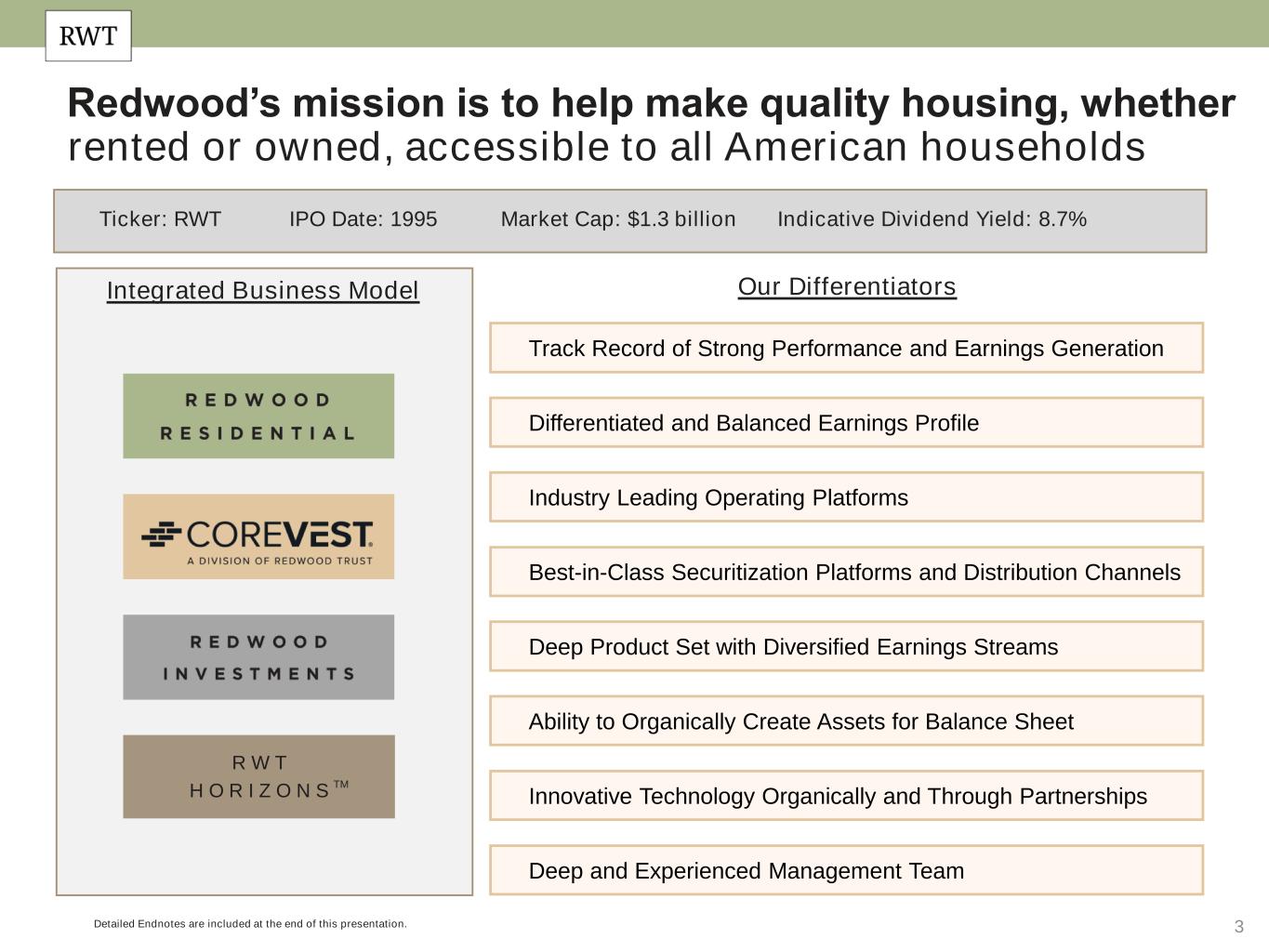
3 Redwood’s mission is to help make quality housing, whether rented or owned, accessible to all American households R W T H O R I Z O N S Innovative Technology Organically and Through Partnerships Industry Leading Operating Platforms Ability to Organically Create Assets for Balance Sheet Best-in-Class Securitization Platforms and Distribution Channels Differentiated and Balanced Earnings Profile Integrated Business Model Our Differentiators Deep Product Set with Diversified Earnings Streams Track Record of Strong Performance and Earnings Generation Deep and Experienced Management Team Ticker: RWT IPO Date: 1995 Market Cap: $1.3 billion Indicative Dividend Yield: 8.7% Detailed Endnotes are included at the end of this presentation. TM

4Detailed Endnotes are included at the end of this presentation. Details regarding non-GAAP measures, including Adjusted Return on Capital, are included in the Endnotes. Business Purpose Mortgage Banking (“BPL”) Strategy | Products Average Q1’22 Capital Allocation Annualized Addressable Market Opportunity(2) ~$100bn Per Year (Single Family Rental + Multifamily) Leading direct lender to single-family and multifamily housing investors; product set includes both term and bridge loans Complementary Business Lines Drive Balanced and Durable Earnings LTM Annualized Return on Capital (GAAP | Adjusted)(1) $190mm 19% | 29% Residential Mortgage Banking $300mm ~$650bn Per Year Market leading non-Agency correspondent platform serving 150+ bank and non-bank originators 16% | 16% We are the leading operator and strategic capital provider for sustainable innovation in housing finance Investment Portfolio Includes assets organically created through mortgage banking activities and investments sourced through other partnerships and third- parties $1.3bn 23% | 14% ~$13bn Per Year

5 Redwood Q1’22 Financial Highlights $31 million, or $0.24 per diluted share ▪ 8.6% Return on Equity (annualized) $1.8 billion of capital Detailed Endnotes are included at the end of this presentation. GAAP Net Income GAAP Book Value Common Dividend Capital Allocation(3) Adj. Return on Capital(4) Capital and Financing Recourse Leverage Ratio(5) Unrestricted Cash ($mm) $12.06 $12.01 Q4'21 Q1'22 $0.23 $0.23 Q4'21 Q1'22 $0.34 $0.24 Q4'21 Q1'22 2.4x 2.1x Q4'21 Q1'22 10% 29% 17% 10% 0% 17% Residential Mortgage Banking Business Purpose Mortgage Banking Investment Portfolio Q4'21 Q1'22 $450 $409 Q4'21 Q1'22 Investment Portfolio 74% Residential Mortgage Banking 16% Business Purpose Mortgage Banking 10% Q1’22 Total Economic Return:(1) 1.5% 8.7% indicative dividend yield as of March 31, 2022(2) Adjusted return on capital is a non-GAAP measure that is reconciled to GAAP return on capital on slide 32 in the Endnotes.

6 Redwood Q1’22 Business Highlights Detailed Endnotes are included at the end of this presentation. ▪ $2.6 billion of locks(1) and $2.0 billion of loan purchases ▪ $1.8 billion of whole loan sales and one securitization of $0.7 billion of loans ▪ Gross margins of 71bps, near low end of our 75 – 100bps historical target range despite substantial Q1’22 volatility(2) Residential Mortgage Banking ▪ Cash and cash equivalents of $409 million represented 66% of marginable debt(3) ▪ Available capital was $140 million as of March 31, 2022(4) ▪ Successfully renewed $2.2 billion of warehouse capacity RWT Horizons Financing & Capital ▪ Made a $25 million commitment to an investment vehicle with mission of providing quality workforce housing opportunities in key Bay Area urban communitiesESG ▪ 2nd consecutive quarter of record funded volumes ▪ $920 million of quarterly fundings (+25% QoQ) ▪ Continued growth in the bridge portfolio (bridge fundings +13% QoQ) ▪ Completed $332 million in sales of single-family rental (“SFR”) loans to large institutional buyers Business Purpose Mortgage Banking TM ▪ Deployed $128 million of capital into new investments (including internally sourced investments and home equity investments (“HEI”)) ▪ Called $102 million of seasoned jumbo collateral in Q1’22 ▪ Overall portfolio credit was strong, supported by continued low delinquencies Investment Portfolio ▪ Completed five new investments in Q1’22 (including two through our partnership with Frontiers Capital) ▪ Two RWT Horizons companies completed follow-on funding rounds in the first quarter ▪ Announced dedicated Chief Investment Officer for the venture, a notable step in solidifying RWT Horizons as a permanent fixture of our unified platform

7 1.00% 2.00% 3.00% 4.00% 5.00% Q2'21 Q3'21 Q4'21 Q1'22 C o s t o f F u n d s Recourse Non-Recourse Attractive Funding Structure Our overall funding structure limits our exposure to rising interest rates and is well constructed for the current environment Cost of Funds Summary ▪ Redwood has limited funding sensitivity to rising interest rates given both fixed rate funding and short-term floating rate liabilities match-funded for short-term or floating rate inventory ▪ We actively and consistently manage our cost of funds ▪ During Q1’22, we renewed facilities representing ~$2 billion of capacity at terms consistent with or superior to previous levels ▪ As of March 31, 2022, we have ~$2.3 billion of excess capacity on loan warehouse facilities ▪ Unsecured corporate debt has laddered maturities from 2023- 2025 and beyond Summary of $3.1 Billion of Secured Debt Financing(1) ▪ This debt finances our Residential and BPL loans held in inventory ▪ Predominantly short-term, floating rate debt ▪ Loan inventory held on average 1-3 months, minimizing overall rate risk which we also hedge ▪ New loans originated/locked daily at current market rates, while existing inventory is sold or securitized Mortgage Banking Funding ▪ ~45% ($1.4 billion) of debt finances our Mortgage Banking Segments ▪ This debt finances certain assets in our investment portfolio ▪ 60% of this debt is related to our holdings of bridge loans which on average have terms of 12 to 18 months and are predominantly variable rate ▪ None of our BPL loan inventory is funded on marginable warehouse lines ▪ The remaining 40% is predominantly fixed rate with a term greater than 1 year Investment Portfolio Funding ▪ ~55% ($1.7 billion) of debt finances our Investment Portfolio Segment Detailed Endnotes are included at the end of this presentation. Refinancings of higher cost debt have driven down costs
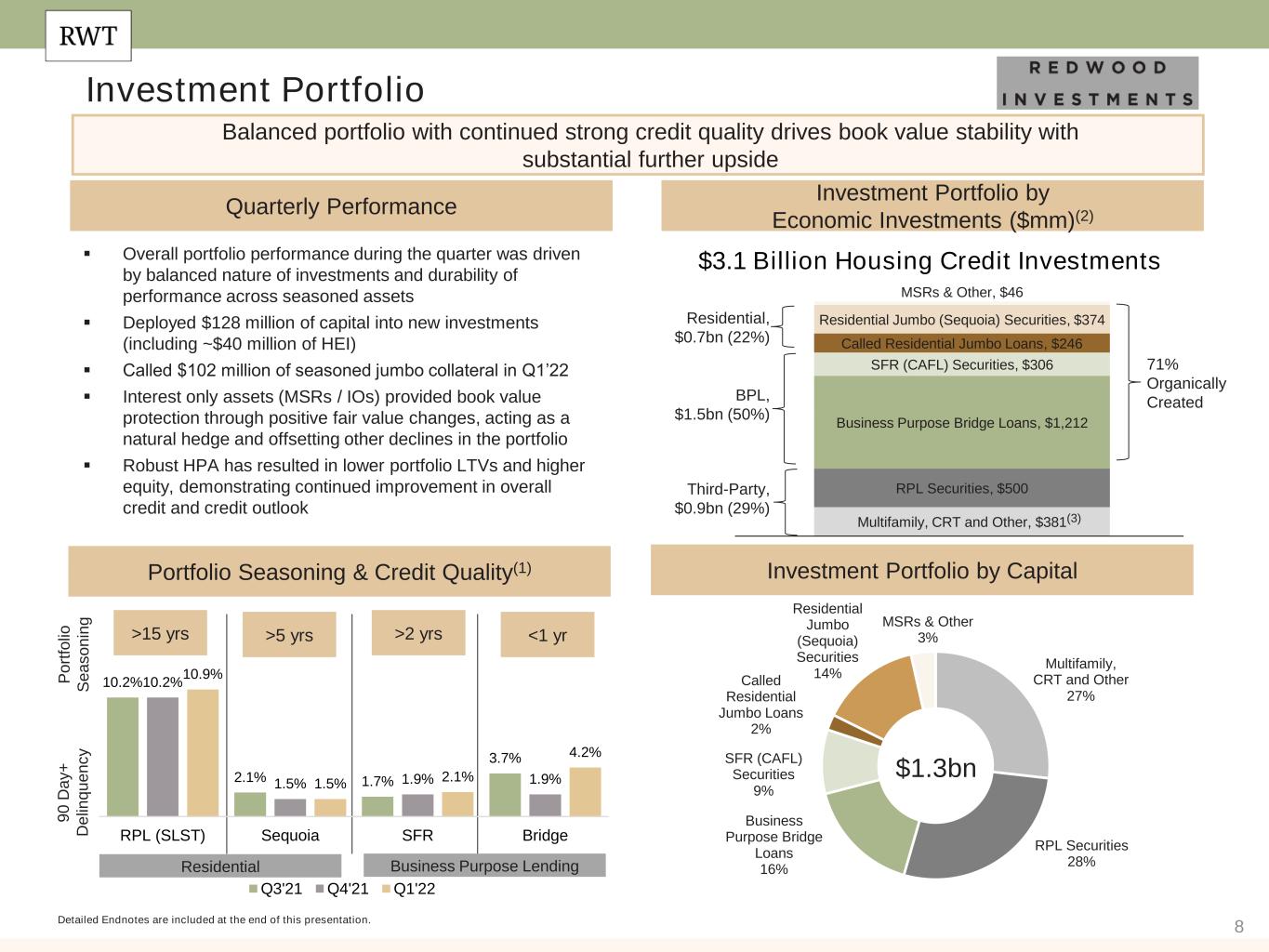
8 Multifamily, CRT and Other, $381 RPL Securities, $500 Business Purpose Bridge Loans, $1,212 SFR (CAFL) Securities, $306 Called Residential Jumbo Loans, $246 Residential Jumbo (Sequoia) Securities, $374 MSRs & Other, $46 Multifamily, CRT and Other 27% RPL Securities 28% Business Purpose Bridge Loans 16% SFR (CAFL) Securities 9% Called Residential Jumbo Loans 2% Residential Jumbo (Sequoia) Securities 14% MSRs & Other 3% Investment Portfolio Investment Portfolio by Economic Investments ($mm)(2)Quarterly Performance ▪ Overall portfolio performance during the quarter was driven by balanced nature of investments and durability of performance across seasoned assets ▪ Deployed $128 million of capital into new investments (including ~$40 million of HEI) ▪ Called $102 million of seasoned jumbo collateral in Q1’22 ▪ Interest only assets (MSRs / IOs) provided book value protection through positive fair value changes, acting as a natural hedge and offsetting other declines in the portfolio ▪ Robust HPA has resulted in lower portfolio LTVs and higher equity, demonstrating continued improvement in overall credit and credit outlook $3.1 Billion Housing Credit Investments 71% Organically Created Detailed Endnotes are included at the end of this presentation. 9 0 D a y + D e lin q u e n c y Portfolio Seasoning & Credit Quality(1) Balanced portfolio with continued strong credit quality drives book value stability with substantial further upside Investment Portfolio by Capital $1.3bn Third-Party, $0.9bn (29%) BPL, $1.5bn (50%) Residential, $0.7bn (22%) P o rt fo lio S e a s o n in g >2 yrs>15 yrs <1 yr>5 yrs 10.2% 2.1% 1.7% 3.7% 10.2% 1.5% 1.9% 1.9% 10.9% 1.5% 2.1% 4.2% RPL (SLST) Sequoia SFR Bridge Q3'21 Q4'21 Q1'22 Residential Business Purpose Lending (3)

9 Solid Investment Portfolio Performance Driven by Strong Housing Credit Fundamentals… Detailed Endnotes are included at the end of this presentation. Our investment portfolio is predominantly concentrated in housing credit assets that benefit from positive trends in housing fundamentals ▪ During the first quarter, our investment portfolio continued to benefit from strong tailwinds including rising home equity, low unemployment and historically low housing inventory ▪ Despite a general trend of wider spreads in the market, book value was relatively flat due to the seasoned nature of our investments, balanced portfolio, housing credit focus and low leverage (1.3x) ▪ We target investments that have a lower sensitivity to interest rate risk relative to housing credit risk Investment Portfolio Composition Summary Category Example Investments Description Seasoned Credit Securities • RPL, Residential & SFR Subordinate Securities, Multifamily B- Pieces Predominantly seasoned credit investments that have experienced significant HPA and represent strong credit profiles Bespoke Housing Investments • Bridge Loan Investments, Seasoned Excess Servicing Investments, HEI Higher yielding investments that are less sensitive to changes in interest rates Interest Only Investments • MSRs, IO- Securities Investments that benefit from rising rates Other • CRT, SFR IOs, Called Jumbo Loans Other housing related investments Composition by Capital(1) $1.3bn Seasoned Credit Securities 47% Bespoke Housing Investments 32% Interest Only Investments 7% Other 15%

10 $10.76 $1.25 $12.01 $0.34 $2.15 $8.00 $10.00 $12.00 $14.00 $16.00 Book Value 3/31/21 YoY Change in Book Value Book value 3/31/22 Potential Premium of Callable Loans(1) Potential Book Value Upside on Securities(2) B o o k V a lu e p e r S h a re YoY Actual Book Value Build Detailed Endnotes are included at the end of this presentation. Potential Book Value Build F U R T H E R U P S I D E T O B O O K V A L U E • We estimate that ~$2.1 billion of additional loans in Sequoia deals could become callable by the end of 2024, including $0.6 billion by the end of 2022(1) • While slowing prepayment speeds on the back of higher rates has prolonged the time to reach our near-term callable loan estimates, we still estimate significant call opportunity in our portfolio over the next 12 to 24 months • At March 31, 2022, our securities portfolio had approximately $259 million of net discount to par value, which we have the potential to realize over time Looking Forward – 2022 and Beyond …and We See Additional Drivers of Long-Term Potential Book Value Upside

11 Redwood’s Book Value in a Rising Rate Environment Detailed Endnotes are included at the end of this presentation. ▪ During the last Fed rate hike cycle, Redwood’s book value increased 9% while delivering total economic return of 35% and an average quarterly dividend yield of 7.4% ▪ Since the last Fed rate hike cycle ended, we have further diversified our revenue streams into areas less correlated with rates ▪ Entering the BPL business - which includes short-term and prepay protected assets – provides a critical business hedge to rising interest rates RWT Book Value Performance During Previous Fed Hike Cycle B o o k V a lu e p e r S h a re 0.00 0.50 1.00 1.50 2.00 2.50 3.00 3.50 $13.00 $14.00 $15.00 $16.00 $17.00 Q4'15 Q1'16 Q2'16 Q3'16 Q4'16 Q1'17 Q2'17 Q3'17 Q4'17 Q1'18 Q2'18 Q3'18 Q4'18 Q1'19 Q2'19 RWT Book Value Fed Funds Target Rate First rate hike announced in December 2015 The Fed cut rates in July 2019 Redwood ook alue erfor ance uring revious ed Rat Hike Cycle 10 Yr Treasury We delivered strong book value and total economic returns during the previous Fed rate hike cycle Relative Performance During Last Fed Hike(1) Q4’15 – Q2’19 9% -13% -23% -9% 35% 12% -3% 17% Redwood mREIT Avg Agency Avg Hybrid Avg BV Total Economic Return R a te s

12 Multifamily 27% Renovate / Build to Rent 15% Fix and Flip 2%Other 1% SFR 55% Business Purpose Mortgage Banking Quarterly Highlights Composition of Quarterly Fundings(1) Detailed Endnotes are included at the end of this presentation. ▪ CoreVest achieved record quarterly funded volume of $920 million (+25% QoQ) driven by continued increase in market share and sponsor demand ▪ Strong momentum in both SFR (+38% QoQ) and Bridge (+13% QoQ) product lines ▪ Demand for multifamily has remained elevated and our volumes have continued to grow (+66% QoQ) ▪ Eclipsed $9 billion of loan fundings since inception ▪ Launched new short-term rental product and closed inaugural term loan backed by short-term rental portfolio ▪ Completed new warehouse financings at attractive levels with additional significant committed financings on track for Q2’22 CoreVest continues to see record volumes even as rates have moved higher; demand remains strong across SFR and Bridge products 10 Yr Treasury 1 0 Y r T re a s u ry $253 $312 $394 $366 $505 $133 $215 $245 $367 $415 $386 $527 $639 $733 $920 Q1'21 Q2'21 Q3'21 Q4'21 Q1'22 SFR Bridge Quarterly Funded Volume ($mm) SFR (55%) Bridge (45%) +25% QoQ

13 Business Purpose Lending Market Opportunity CoreVest DifferentiatorsAppeal for BPL Continues to Strengthen ✓ Broad suite of products with proven scale, track record and distribution ✓ Organic growth in lending book through mature platform and deep bench that outperforms the market ✓ Data-driven marketing, lead generation and scalable sales processes ✓ Leading technology platform drives efficiency and superior closing times ✓ Strong network of builders across the country – geographically diverse Estimated CoreVest Market Share Growth Detailed Endnotes are included at the end of this presentation. Current industry dynamics continue to support growth in business purpose lending and demand for CoreVest’s diverse product suite Rental Growth vs Rising HPA(2) CoreVest’s Growing Market Share in a Growing Market ✓ BPL is an attractive and growing industry with less cyclical attributes ✓ In Q1’22, SFR occupancy rates grew 10% YoY, rents grew 7% YoY, turnover fell 110 bps YoY and new lease rates accelerated to 16.2%(1) ✓ Housing supply / inventory remains low with heightened demand for new and refurbished homes ✓ Historically tight lending standards are also driving rental demand; fundamental shift in bias towards renting ✓ Millennials transitioning from apartments to SFR 1.00 1.05 1.10 1.15 1.20 1.25 1.30 0.00% 5.00% 10.00% 15.00% 20.00% 25.00% 2013 2014 2015 2016 2017 2018 2019 2020 2021 Y o Y R e n t G ro w th Y o Y H P A G ro w th HPA Growth Rent Growth 1.4% 2.3% 3.7% 2020 2021 2022 Annualized
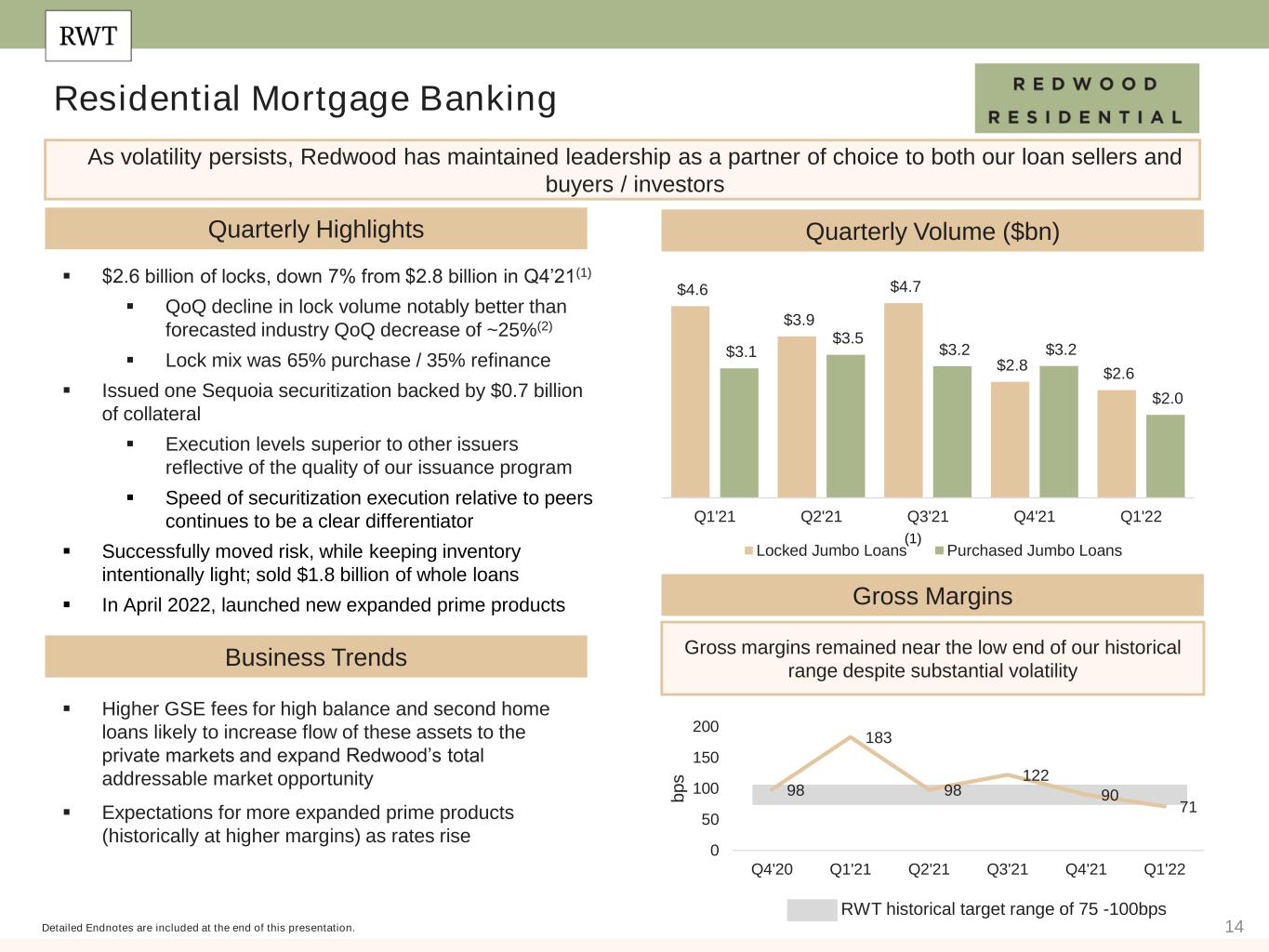
14 $4.6 $3.9 $4.7 $2.8 $2.6 $3.1 $3.5 $3.2 $3.2 $2.0 Q1'21 Q2'21 Q3'21 Q4'21 Q1'22 Locked Jumbo Loans Purchased Jumbo Loans Residential Mortgage Banking Quarterly Volume ($bn) Gross Margins Quarterly Highlights Business Trends ▪ $2.6 billion of locks, down 7% from $2.8 billion in Q4’21(1) ▪ QoQ decline in lock volume notably better than forecasted industry QoQ decrease of ~25%(2) ▪ Lock mix was 65% purchase / 35% refinance ▪ Issued one Sequoia securitization backed by $0.7 billion of collateral ▪ Execution levels superior to other issuers reflective of the quality of our issuance program ▪ Speed of securitization execution relative to peers continues to be a clear differentiator ▪ Successfully moved risk, while keeping inventory intentionally light; sold $1.8 billion of whole loans ▪ In April 2022, launched new expanded prime products ▪ Higher GSE fees for high balance and second home loans likely to increase flow of these assets to the private markets and expand Redwood’s total addressable market opportunity ▪ Expectations for more expanded prime products (historically at higher margins) as rates rise RWT historical target range of 75 -100bps Detailed Endnotes are included at the end of this presentation. As volatility persists, Redwood has maintained leadership as a partner of choice to both our loan sellers and buyers / investors Gross margins remained near the low end of our historical range despite substantial volatility (1) 98 183 98 122 90 71 0 50 100 150 200 Q4'20 Q1'21 Q2'21 Q3'21 Q4'21 Q1'22 b p s

15 Redwood Residential Launches Expanded Credit Products ▪ In April 2022, Redwood Residential launched new expanded product offerings through our Choice Program and a new product geared towards addressing the growing cohort of self-employed borrowers ▪ As Redwood continues to support avenues for greater housing affordability, we believe these products should translate into better pricing for our sellers, more loan options for their borrowers and greater market share opportunities for Redwood “Redwood has a long and successful history of innovating and providing residential products that address the evolving needs of homeowners…We have structured these new products to be uniquely differentiated, competitively priced, and to promote enhanced liquidity in the private-label securitization market.” – Fred Matera, Managing Director and Head of Redwood Residential New Products Meet the Growing Market Demand Detailed Endnotes are included at the end of this presentation. Expanded Choice Products Self- Employed Products ▪ Allows for primary use of business and personal bank statements in underwriting process ▪ Structured to meet the CFPB’s Qualified Mortgage (“QM”) definition ▪ Allows for additional borrower eligibility criteria, loans that exceed the APOR threshold ▪ Departure Residence feature with the departure payment excluded 0.0 1.0 2.0 3.0 4.0 5.0 2011 2012 2013 2014 2015 2016 2017 2018 2019 2020 2021 2022 M o n th ly Q u it s (F ig u re s m ill io n s ) Many of these workers entering self-employment have high- quality credit and will need to buy a house or refinance an existing home loan. These borrowers do not qualify for traditional GSE loans. Growing Number of Employees are Quitting and Entering Self-Employment(1) In April, we announced new residential expanded credit products, further demonstrating our ability to provide products that address evolving market needs and opportunities

16 FHFA Changes Create Opportunity for Redwood to Increase Allocation to High Balance Loans ▪ On April 1, 2022, the revised GSE Enterprise Pricing Framework went into effect, increasing upfront LLPA fees for high balance loans and loans on second homes ▪ We anticipate that these increased fees and the impact on pricing will result in more of these loans flowing into the private market “The FHFA’s announcement provides welcome additional alignment between private capital and the GSEs in furthering our collective goals for housing access and affordability. Redwood remains a highly complementary partner to the GSEs and we view these changes to be constructive for non-agency origination volumes overall.” - Chris Abate, Chief Executive Officer Redwood has a Strong History of Purchasing High Balance Loans ▪ In 2018, nearly 20% of Redwood’s purchase volume was in high balance loans, as private label execution compared favorably to the GSEs ▪ Given the recent effective date of these changes, we would anticipate our purchases of high balance loans to once again increase 0% 5% 10% 15% 20% 25% $0 $50 $100 $150 $200 $250 $300 $350 $400 $450 Q1'17 Q2'17 Q3'17 Q4'17 Q1'18 Q2'18 Q3'18 Q4'18 Q1'19 Q2'19 Q3'19 Q4'19 % o f T o ta l R W T P u rc h a s e s P u rc h a s e d H ig h B a la n c e L o a n s ( $ m m ) % of Total RWT Purchases: ~16% Leading up to and following the LLPA fee increase on April 1, 2022, Redwood has seen an increase in pools of high balance and second home loans Detailed Endnotes are included at the end of this presentation. Purchased High Balance Loans % of Total RWT Purchases
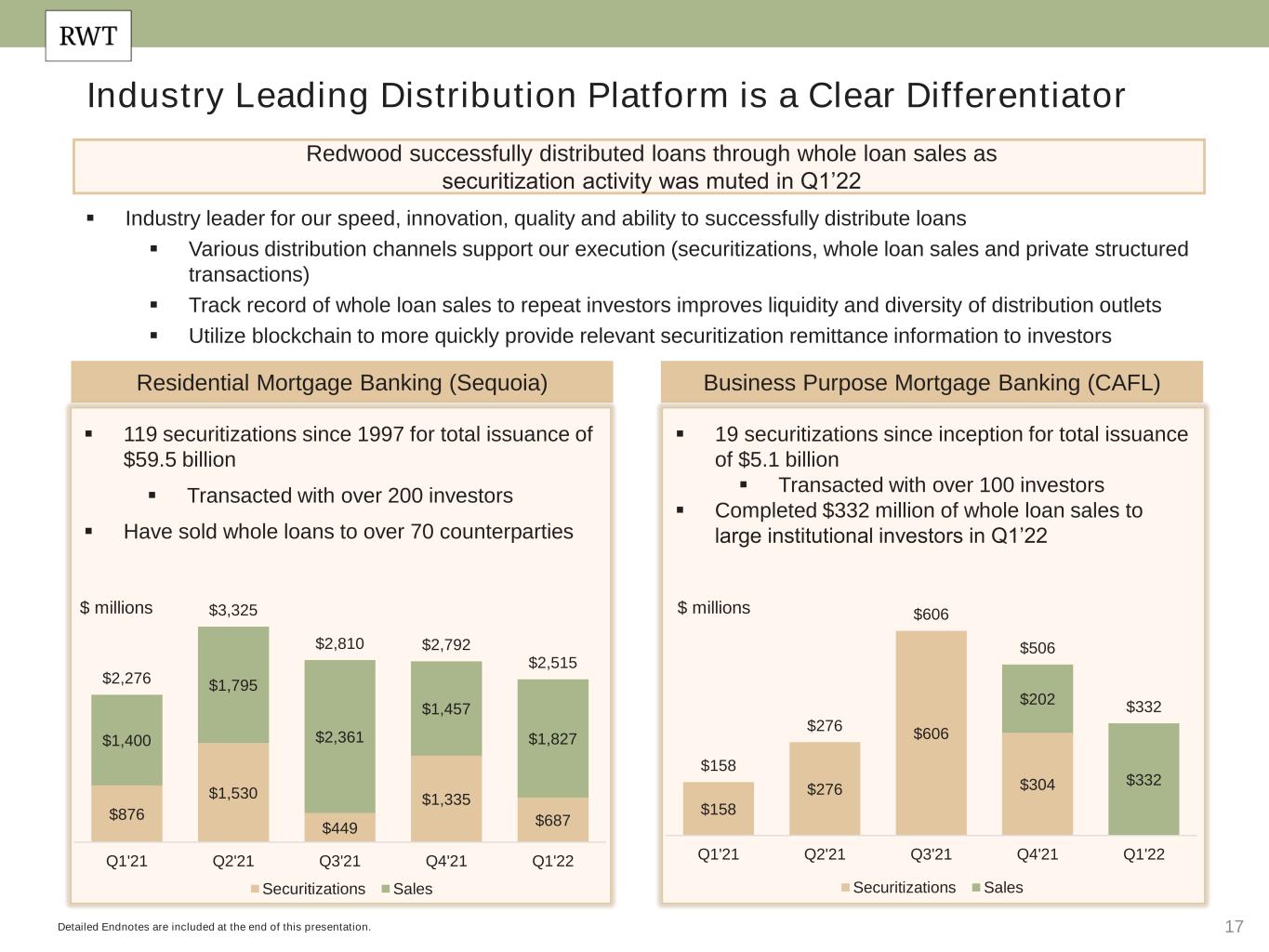
17 Industry Leading Distribution Platform is a Clear Differentiator Business Purpose Mortgage Banking (CAFL)Residential Mortgage Banking (Sequoia) Detailed Endnotes are included at the end of this presentation. ▪ Industry leader for our speed, innovation, quality and ability to successfully distribute loans ▪ Various distribution channels support our execution (securitizations, whole loan sales and private structured transactions) ▪ Track record of whole loan sales to repeat investors improves liquidity and diversity of distribution outlets ▪ Utilize blockchain to more quickly provide relevant securitization remittance information to investors ▪ 119 securitizations since 1997 for total issuance of $59.5 billion ▪ Transacted with over 200 investors ▪ Have sold whole loans to over 70 counterparties ▪ 19 securitizations since inception for total issuance of $5.1 billion ▪ Transacted with over 100 investors ▪ Completed $332 million of whole loan sales to large institutional investors in Q1’22 Redwood successfully distributed loans through whole loan sales as securitization activity was muted in Q1’22 $ millions$ millions $876 $1,530 $449 $1,335 $687 $1,400 $1,795 $2,361 $1,457 $1,827 $2,276 $3,325 $2,810 $2,792 $2,515 Q1'21 Q2'21 Q3'21 Q4'21 Q1'22 Securitizations Sales $158 $276 $606 $304 $202 $332 $158 $276 $606 $506 $332 Q1'21 Q2'21 Q3'21 Q4'21 Q1'22 Securitizations Sales

18 R W T H O R I Z O N S Horizons by the NumbersQ1’22 Activity Detailed Endnotes are included at the end of this presentation. Invests in primarily early-stage companies that drive innovation in financial and real estate technology TM ▪ 5 additional investments in Q1’22(1) Horizons Opportunity Thesis Enhance efficiency and scale in Redwood businesses Early-stage companies with opportunity for valuation upside Partnerships drive growth and technological enhancements Alignment with Redwood’s mission, values and goals P P P P Over $25 million of investment commitments since inception 21 total investments 18 portfolio companies
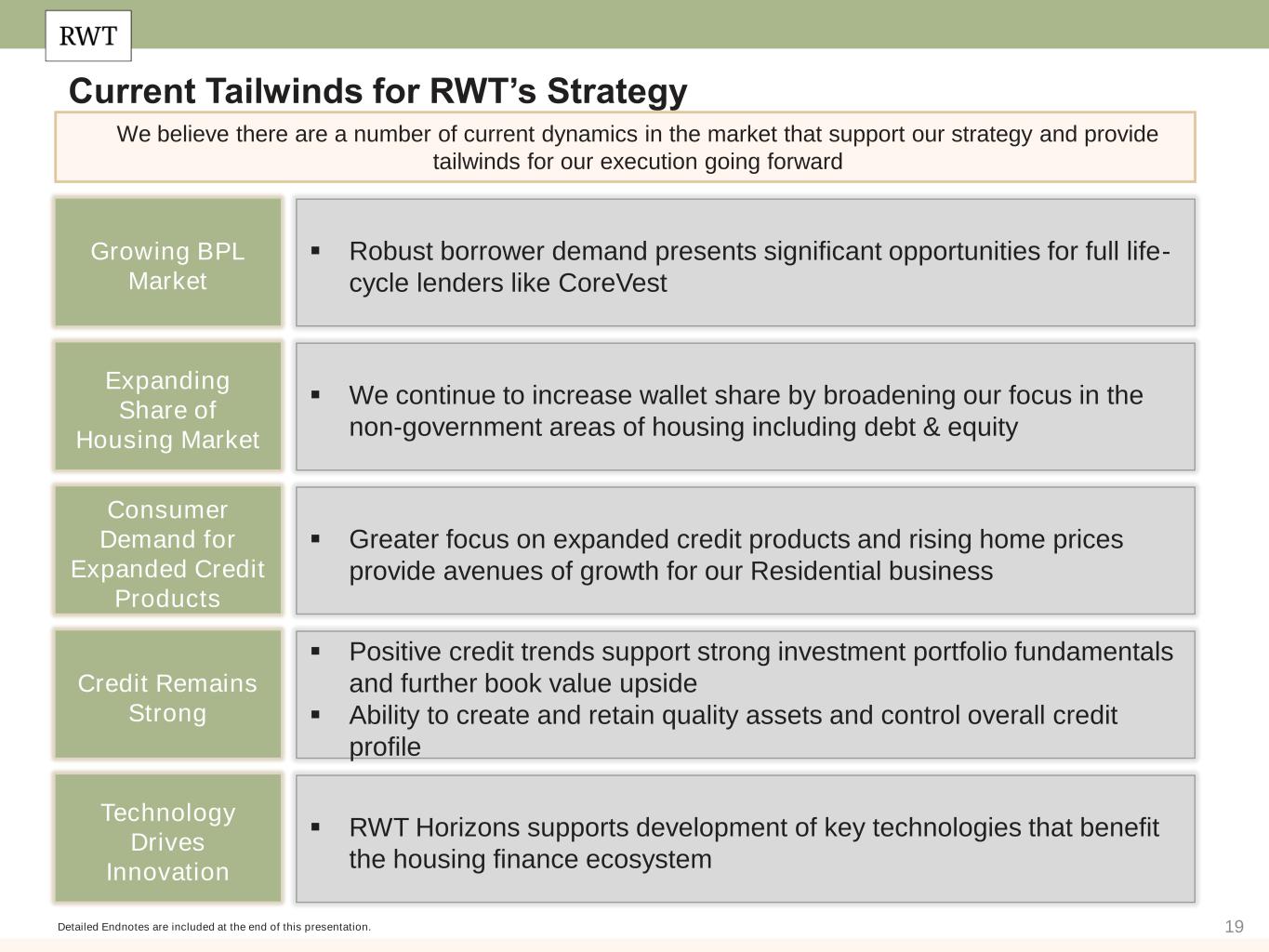
19 Current Tailwinds for RWT’s Strategy Expanding Share of Housing Market Consumer Demand for Expanded Credit Products Technology Drives Innovation Credit Remains Strong ▪ We continue to increase wallet share by broadening our focus in the non-government areas of housing including debt & equity ▪ Greater focus on expanded credit products and rising home prices provide avenues of growth for our Residential business ▪ Positive credit trends support strong investment portfolio fundamentals and further book value upside ▪ Ability to create and retain quality assets and control overall credit profile ▪ RWT Horizons supports development of key technologies that benefit the housing finance ecosystem Detailed Endnotes are included at the end of this presentation. Growing BPL Market ▪ Robust borrower demand presents significant opportunities for full life- cycle lenders like CoreVest We believe there are a number of current dynamics in the market that support our strategy and provide tailwinds for our execution going forward
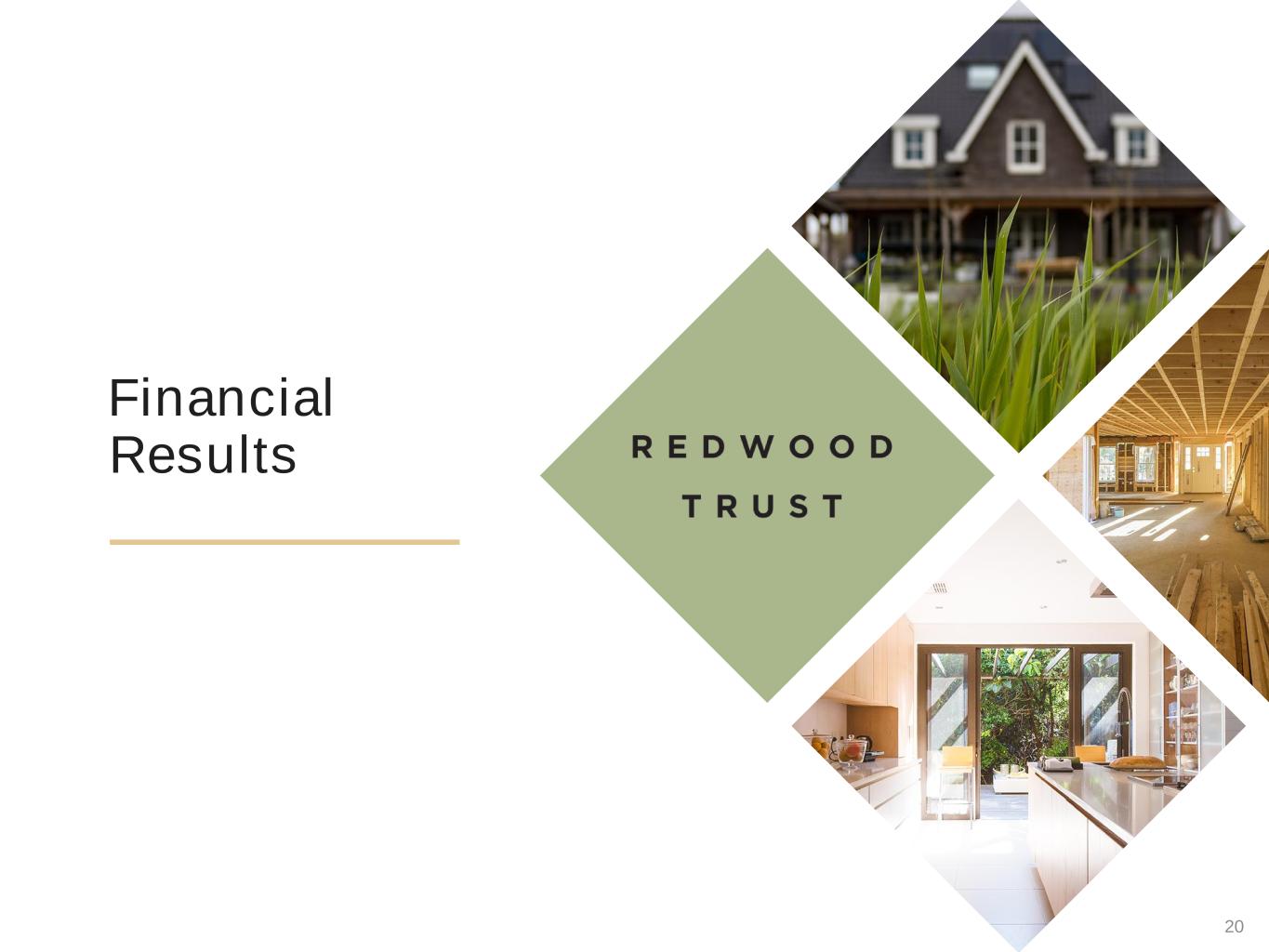
20 Financial Results

21 Detailed Endnotes are included at the end of this presentation.

22 Detailed Endnotes are included at the end of this presentation.
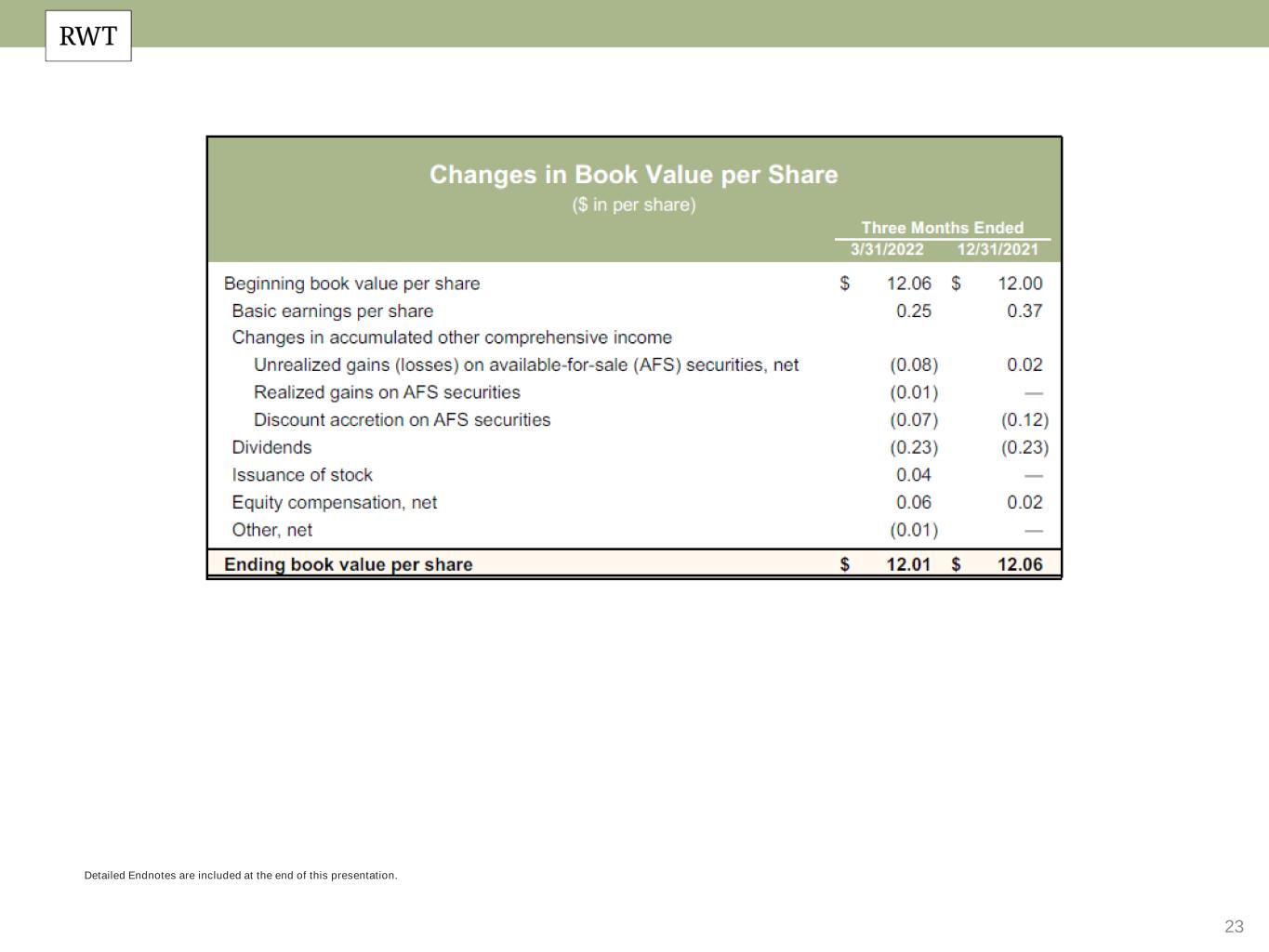
23 (1) Detailed Endnotes are included at the end of this presentation.

24 Detailed Endnotes are included at the end of this presentation.

25 Detailed Endnotes are included at the end of this presentation.
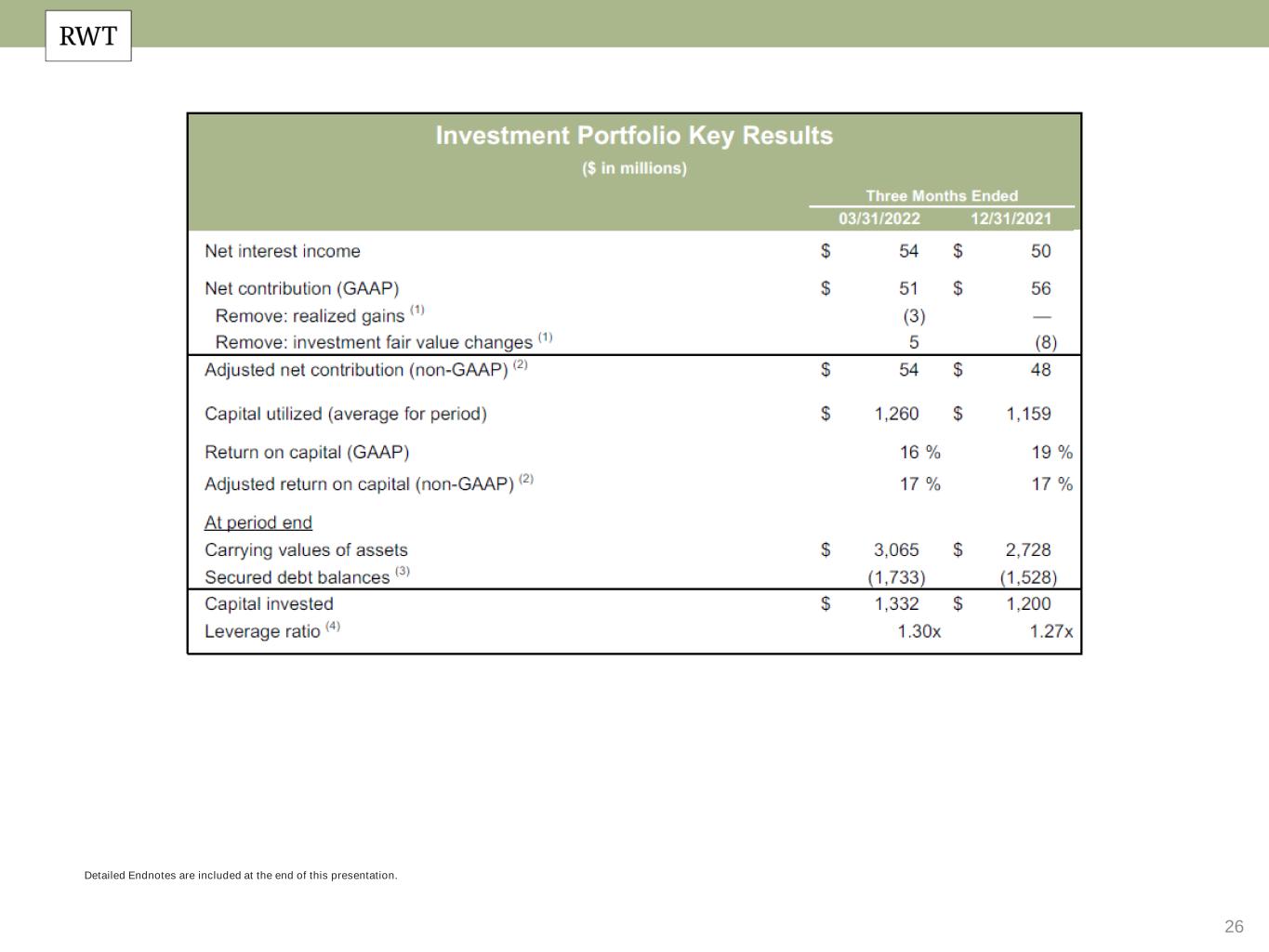
26 Detailed Endnotes are included at the end of this presentation.

27 Detailed Endnotes are included at the end of this presentation.

28 Detailed Endnotes are included at the end of this presentation.

29 Detailed Endnotes are included at the end of this presentation.
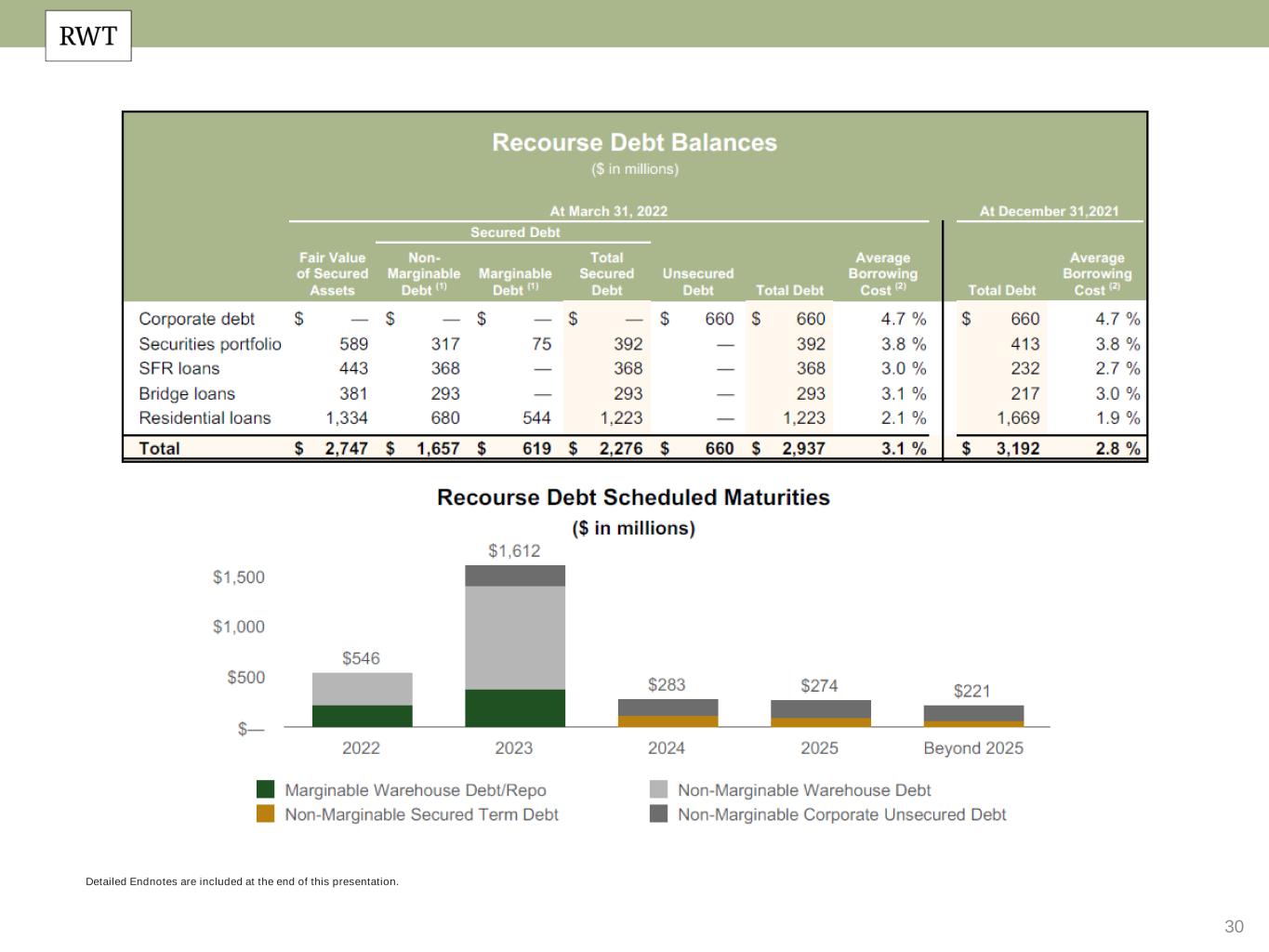
30 Detailed Endnotes are included at the end of this presentation.

31 Endnotes
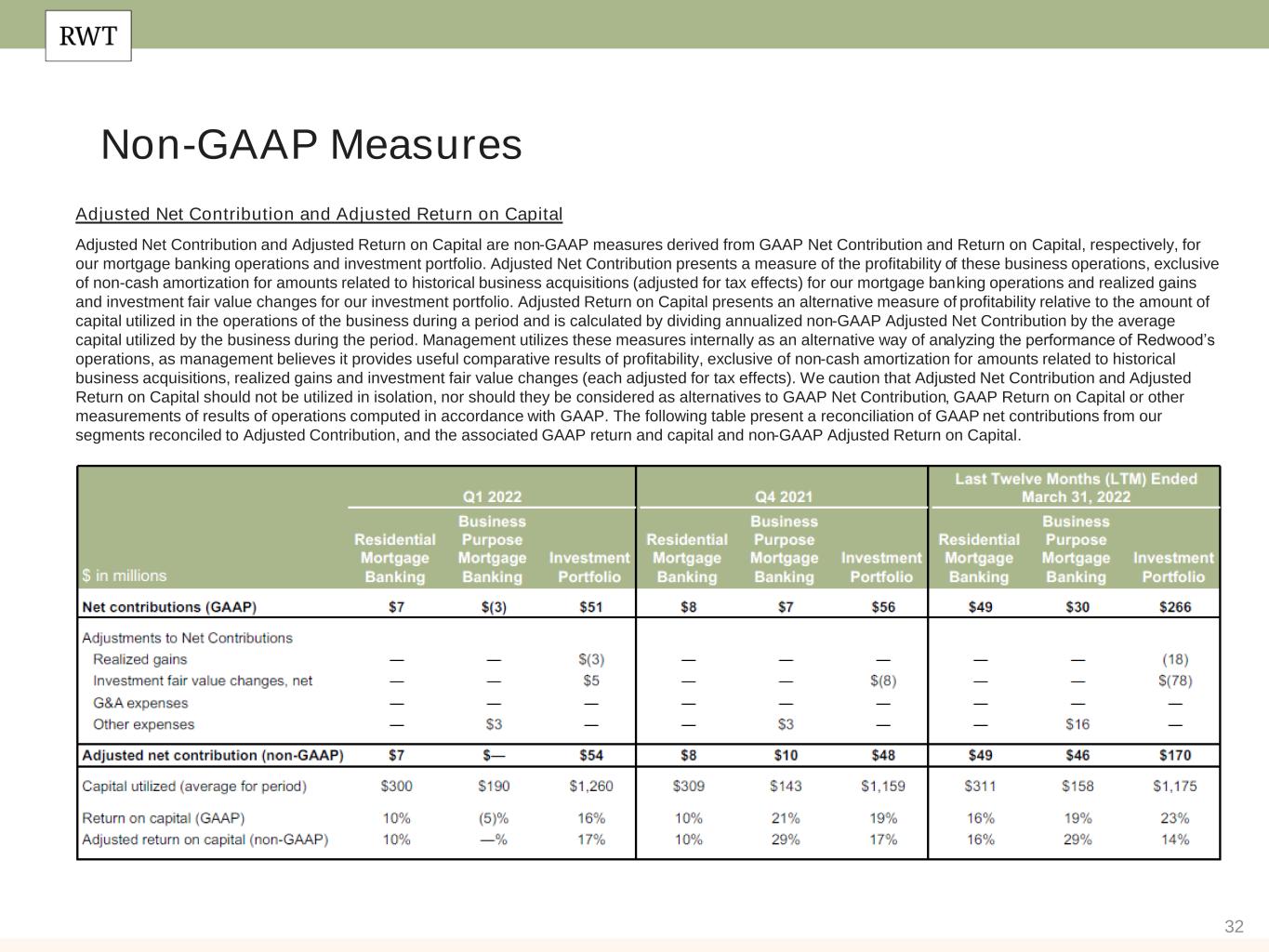
32 Non-GAAP Measures Adjusted Net Contribution and Adjusted Return on Capital Adjusted Net Contribution and Adjusted Return on Capital are non-GAAP measures derived from GAAP Net Contribution and Return on Capital, respectively, for our mortgage banking operations and investment portfolio. Adjusted Net Contribution presents a measure of the profitability of these business operations, exclusive of non-cash amortization for amounts related to historical business acquisitions (adjusted for tax effects) for our mortgage banking operations and realized gains and investment fair value changes for our investment portfolio. Adjusted Return on Capital presents an alternative measure of profitability relative to the amount of capital utilized in the operations of the business during a period and is calculated by dividing annualized non-GAAP Adjusted Net Contribution by the average capital utilized by the business during the period. Management utilizes these measures internally as an alternative way of analyzing the performance of Redwood’s operations, as management believes it provides useful comparative results of profitability, exclusive of non-cash amortization for amounts related to historical business acquisitions, realized gains and investment fair value changes (each adjusted for tax effects). We caution that Adjusted Net Contribution and Adjusted Return on Capital should not be utilized in isolation, nor should they be considered as alternatives to GAAP Net Contribution, GAAP Return on Capital or other measurements of results of operations computed in accordance with GAAP. The following table present a reconciliation of GAAP net contributions from our segments reconciled to Adjusted Contribution, and the associated GAAP return and capital and non-GAAP Adjusted Return on Capital. $ in millions
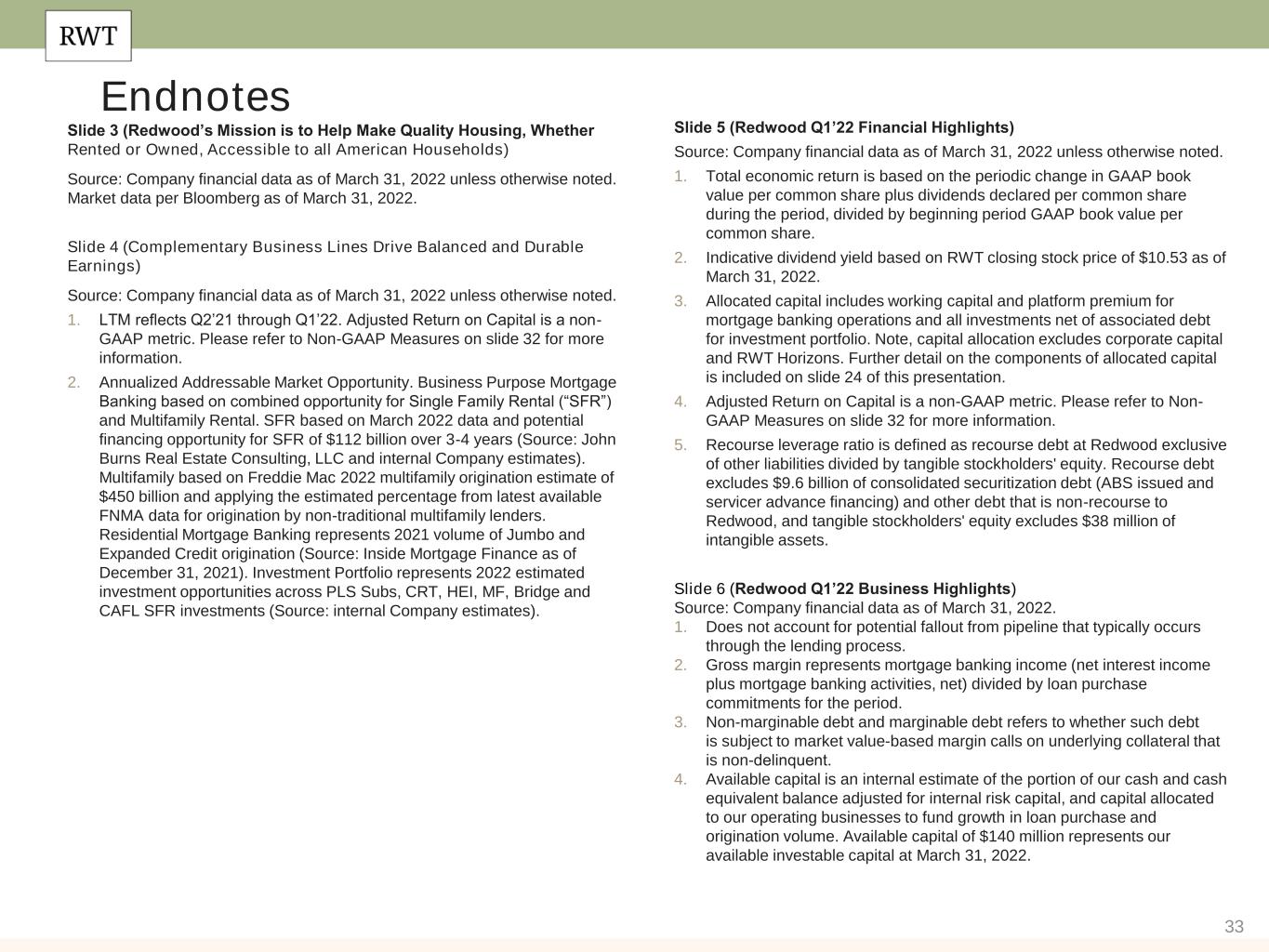
33 Slide 3 (Redwood’s Mission is to Help Make Quality Housing, Whether Rented or Owned, Accessible to all American Households) Source: Company financial data as of March 31, 2022 unless otherwise noted. Market data per Bloomberg as of March 31, 2022. Slide 4 (Complementary Business Lines Drive Balanced and Durable Earnings) Source: Company financial data as of March 31, 2022 unless otherwise noted. 1. LTM reflects Q2’21 through Q1’22. Adjusted Return on Capital is a non- GAAP metric. Please refer to Non-GAAP Measures on slide 32 for more information. 2. Annualized Addressable Market Opportunity. Business Purpose Mortgage Banking based on combined opportunity for Single Family Rental (“SFR”) and Multifamily Rental. SFR based on March 2022 data and potential financing opportunity for SFR of $112 billion over 3-4 years (Source: John Burns Real Estate Consulting, LLC and internal Company estimates). Multifamily based on Freddie Mac 2022 multifamily origination estimate of $450 billion and applying the estimated percentage from latest available FNMA data for origination by non-traditional multifamily lenders. Residential Mortgage Banking represents 2021 volume of Jumbo and Expanded Credit origination (Source: Inside Mortgage Finance as of December 31, 2021). Investment Portfolio represents 2022 estimated investment opportunities across PLS Subs, CRT, HEI, MF, Bridge and CAFL SFR investments (Source: internal Company estimates). Endnotes Slide 5 (Redwood Q1’22 Financial Highlights) Source: Company financial data as of March 31, 2022 unless otherwise noted. 1. Total economic return is based on the periodic change in GAAP book value per common share plus dividends declared per common share during the period, divided by beginning period GAAP book value per common share. 2. Indicative dividend yield based on RWT closing stock price of $10.53 as of March 31, 2022. 3. Allocated capital includes working capital and platform premium for mortgage banking operations and all investments net of associated debt for investment portfolio. Note, capital allocation excludes corporate capital and RWT Horizons. Further detail on the components of allocated capital is included on slide 24 of this presentation. 4. Adjusted Return on Capital is a non-GAAP metric. Please refer to Non- GAAP Measures on slide 32 for more information. 5. Recourse leverage ratio is defined as recourse debt at Redwood exclusive of other liabilities divided by tangible stockholders' equity. Recourse debt excludes $9.6 billion of consolidated securitization debt (ABS issued and servicer advance financing) and other debt that is non-recourse to Redwood, and tangible stockholders' equity excludes $38 million of intangible assets. Slide 6 (Redwood Q1’22 Business Highlights) Source: Company financial data as of March 31, 2022. 1. Does not account for potential fallout from pipeline that typically occurs through the lending process. 2. Gross margin represents mortgage banking income (net interest income plus mortgage banking activities, net) divided by loan purchase commitments for the period. 3. Non-marginable debt and marginable debt refers to whether such debt is subject to market value-based margin calls on underlying collateral that is non-delinquent. 4. Available capital is an internal estimate of the portion of our cash and cash equivalent balance adjusted for internal risk capital, and capital allocated to our operating businesses to fund growth in loan purchase and origination volume. Available capital of $140 million represents our available investable capital at March 31, 2022.

34 Endnotes Slide 7 (Attractive Funding Structure) Source: Company financial data as of March 31, 2022 unless otherwise noted. 1. $3.1 billion of secured debt includes $2.3 billion of recourse debt and $0.8 billion of non-recourse debt financing bridge loans and SLST securities. Slide 8 (Investment Portfolio) Source: Company financial data as of March 31, 2022 unless otherwise noted. 1. Chart shows 90 day+ delinquencies by product from Q3’21 through Q1’22. Includes loans over 90 days delinquent and all loans in foreclosure (regardless of delinquency status). Delinquency percentages at underlying securitizations are calculated using unpaid principal balance ("UPB"). Aggregate delinquency amounts by security type are weighted using the market value of our investments in each securitization. 2. Figures reflect our investments held in our Investment Portfolio on balance sheet and our economic interests in securities we own in securitizations we consolidate in accordance with GAAP (and excludes the assets within these consolidated securitizations that appear on our balance sheet) as of period end for each of the periods presented. 3. “Multifamily, CRT, and Other” includes $90 million of CRT, $38 million of third-party securities, $56 million of multifamily securities, $99 million investment in legacy servicing assets, $83 million net investment in HEI assets, and $10 million of other multifamily loans and investments. Slide 9 (Solid Investment Portfolio Performance Driven by Strong Housing Credit Fundaments…) Source: Company financial data as of March 31, 2022 unless otherwise noted. 1. Figures reflect capital deployed in investments within our Investment Portfolio. See Investment Portfolio Capital Composition table on slide 28 for detail of these investments by category. Slide 10 (…And We See Additional Drivers of Long-Term Potential Book Value Upside) Source: Company financial data as of March 31, 2022 unless otherwise noted. 1. Potential earnings related to securitization transactions that could become callable are based on our current market observations, estimates, and assumptions, including our assumptions regarding credit losses, prepayment speeds, market interest rates, and discount rates. We estimate that approximately $2.1 billion of additional loans in Sequoia and CAFL deals could become callable by the end of 2024, including $0.6 billion by the end of 2022. The $0.34 per share displayed relates to the estimate for transactions we estimate could become callable by the end of 2024. Actual returns may differ based on these or other factors. 2. Represents potential book value per share upside on the securities portfolio due to the net discount to par value. There are several risk factors that may impact our ability to realize all or a portion of this amount which may be outside our control, these primarily include credit performance and prepayment speeds. Slide 11 (Redwood’s Book Value in a Rising Rate Environment) Source: Company financial data as of March 31, 2022 unless otherwise noted. Market data per Bloomberg as of March 31, 2022. Peer data per CapitalIQ. 1. Agency peers include NLY, AGNC, ARR. Hybrid peers include CIM, MFA, TWO, IVR, PMT, MITT, WMC and EARN. mREIT Average represents the average across both Agency and Hybrid peers. Companies that existed during the previous rate hike cycle that no longer exist or have been acquired are not included in this analysis. .

35 Slide 12 (Business Purpose Mortgage Banking) Source: Company financial data as of March 31, 2022. Market data per Bloomberg as of March 31, 2022. 1. Composition percentages are based on unpaid principal balance. Slide 13 (Business Purpose Lending Market Opportunity) Source: Company financial data as of March 31, 2022. 1. KBW Research: 4Q21-Fiscal 1Q22 Housing Takeaways: Homebuilders and Single Family Rental (April 5, 2022). 2. HPA data per BofA Global Research and Corelogic as of March 2022. Rent Growth data per Beekin as of March 2022. Slide 14 (Residential Mortgage Banking) Source: Company financial data as of March 31, 2022 unless otherwise noted. 1. Does not account for potential fallout from pipeline that typically occurs through the lending process. 2. Source: MBA Mortgage Forecasts as of April 13, 2022. Slide 15 (Redwood Residential Launches Expanded Credit Products) 1. Federal Bureau of Labor Statistics. Slide 16 (FHFA Changes Create Opportunity for Redwood to Increase Allocation to High Balance Loans) Source: Company financial data as of March 31, 2022 unless otherwise noted. Slide 17 (Industry Leading Distribution Platform is a Clear Differentiator) Source: Company financial data as of March 31, 2022 unless otherwise noted. Slide 18 (RWT Horizons) Source: Company financial data as of March 31, 2022 unless otherwise noted. 1. Dwellsy and Vesta Equity investments made in partnership with Frontiers Capital. Endnotes Slide 21 (Appendix: Income Statement) 1. Net interest income from “Corporate (unsecured debt)” consists primarily of interest expense on corporate unsecured debt as well as net interest income from Legacy Sequoia consolidated VIEs. Slide 22 (Appendix: Balance Sheet) 1. The format of this consolidated balance sheet is provided to more clearly delineate between the assets and liabilities belonging to securitization entities (Consolidated VIEs) that we are required to consolidate on our balance sheet in accordance with GAAP, versus the assets that are legally ours and the liabilities of ours for which there is recourse to us (At Redwood). Each of these Consolidated VIEs is independent of Redwood and of each other and the assets and liabilities of these entities are not owned by and are not legal obligations of ours. Our exposure to these entities is primarily through the financial interests we have retained or acquired in these entities (generally subordinate and interest-only securities), the fair value of which is represented by our equity in each entity, as presented in this table. 2. Includes our consolidated Legacy Sequoia, Servicing Investment, and Point entities. 3. Includes certain business purpose bridge and SFR loans and associated non-recourse secured financing. 4. At March 31, 2022, and December 31, 2021, other assets at Redwood included a total of $34 million of assets held by third-party custodians and pledged as collateral to the GSEs in connection with credit risk-sharing arrangements. These pledged assets can only be used to settle obligations to the GSEs under these risk-sharing arrangements.
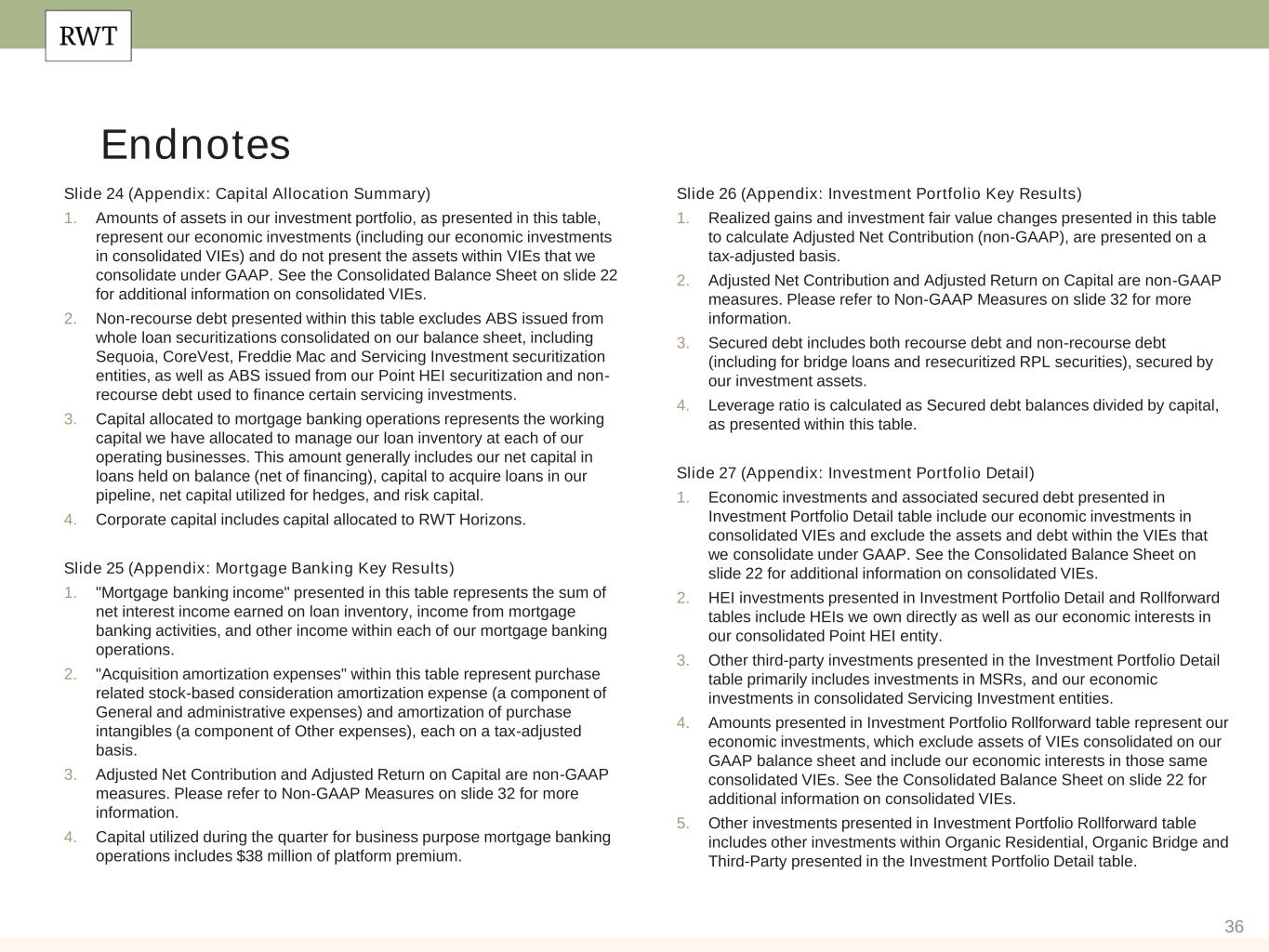
36 Endnotes Slide 24 (Appendix: Capital Allocation Summary) 1. Amounts of assets in our investment portfolio, as presented in this table, represent our economic investments (including our economic investments in consolidated VIEs) and do not present the assets within VIEs that we consolidate under GAAP. See the Consolidated Balance Sheet on slide 22 for additional information on consolidated VIEs. 2. Non-recourse debt presented within this table excludes ABS issued from whole loan securitizations consolidated on our balance sheet, including Sequoia, CoreVest, Freddie Mac and Servicing Investment securitization entities, as well as ABS issued from our Point HEI securitization and non- recourse debt used to finance certain servicing investments. 3. Capital allocated to mortgage banking operations represents the working capital we have allocated to manage our loan inventory at each of our operating businesses. This amount generally includes our net capital in loans held on balance (net of financing), capital to acquire loans in our pipeline, net capital utilized for hedges, and risk capital. 4. Corporate capital includes capital allocated to RWT Horizons. Slide 25 (Appendix: Mortgage Banking Key Results) 1. "Mortgage banking income" presented in this table represents the sum of net interest income earned on loan inventory, income from mortgage banking activities, and other income within each of our mortgage banking operations. 2. "Acquisition amortization expenses" within this table represent purchase related stock-based consideration amortization expense (a component of General and administrative expenses) and amortization of purchase intangibles (a component of Other expenses), each on a tax-adjusted basis. 3. Adjusted Net Contribution and Adjusted Return on Capital are non-GAAP measures. Please refer to Non-GAAP Measures on slide 32 for more information. 4. Capital utilized during the quarter for business purpose mortgage banking operations includes $38 million of platform premium. Slide 26 (Appendix: Investment Portfolio Key Results) 1. Realized gains and investment fair value changes presented in this table to calculate Adjusted Net Contribution (non-GAAP), are presented on a tax-adjusted basis. 2. Adjusted Net Contribution and Adjusted Return on Capital are non-GAAP measures. Please refer to Non-GAAP Measures on slide 32 for more information. 3. Secured debt includes both recourse debt and non-recourse debt (including for bridge loans and resecuritized RPL securities), secured by our investment assets. 4. Leverage ratio is calculated as Secured debt balances divided by capital, as presented within this table. Slide 27 (Appendix: Investment Portfolio Detail) 1. Economic investments and associated secured debt presented in Investment Portfolio Detail table include our economic investments in consolidated VIEs and exclude the assets and debt within the VIEs that we consolidate under GAAP. See the Consolidated Balance Sheet on slide 22 for additional information on consolidated VIEs. 2. HEI investments presented in Investment Portfolio Detail and Rollforward tables include HEIs we own directly as well as our economic interests in our consolidated Point HEI entity. 3. Other third-party investments presented in the Investment Portfolio Detail table primarily includes investments in MSRs, and our economic investments in consolidated Servicing Investment entities. 4. Amounts presented in Investment Portfolio Rollforward table represent our economic investments, which exclude assets of VIEs consolidated on our GAAP balance sheet and include our economic interests in those same consolidated VIEs. See the Consolidated Balance Sheet on slide 22 for additional information on consolidated VIEs. 5. Other investments presented in Investment Portfolio Rollforward table includes other investments within Organic Residential, Organic Bridge and Third-Party presented in the Investment Portfolio Detail table.

37 Endnotes Slide 28 (Appendix: Investment Portfolio Capital Composition) 1. Amounts in table represent our net capital invested in each investment type. See Investment Portfolio Detail table on slide 27 for further detail on our economic investments and associated secured debt by investment type. Slide 29 (Appendix: Investment Portfolio Credit Characteristics) 1. Underlying loan performance information provided in this table is generally reported on a one-month lag. As such, the data reported in this table is from March 2022 reports, which reflect a loan performance date of February 28, 2022. 2. Sequoia Select and Sequoia Choice securities presented in this table include subordinate securities and do not include interest only or certificated servicing securities. 3. HPI updated average LTV is calculated based on the current loan balance and an updated property value amount that is formulaically adjusted from value at origination based on the FHFA home price index (HPI). 4. Delinquency percentages at underlying securitizations are calculated using unpaid principal balance ("UPB"). Aggregate delinquency amounts by security type are weighted using the market value of our investments in each securitization. Includes loans over 90 days delinquent and all loans in foreclosure (regardless of delinquency status). 5. "Investment thickness" represents the average size of the subordinate securities we own as investments in securitizations, relative to the average overall size of the securitizations. For example, if our investment thickness (of first-loss securities) with respect to a particular securitization is 10%, we have exposure to the first 10% of credit losses resulting from loans underlying that securitization. Investment thickness is not applicable to our BPL Bridge Loan investments as they are whole loans. 6. Average current debt service coverage ratio (or DSCR) with respect to a loan is the ratio by which net operating income of the underlying property exceeds its fixed debt costs. 7. Average loan to value (or LTV) (at origination) is calculated based on the original loan amount and the property value at the time the loan was originated. Slide 30 (Appendix: Recourse Debt Balances) 1. Non-Marginable debt and marginable debt refers to whether such debt is subject to market value-based margin calls on underlying collateral that is non-delinquent. 2. Average borrowing cost represents the weighted average contractual cost of recourse debt outstanding at the end of each period presented and does not include deferred issuance costs or debt discounts.